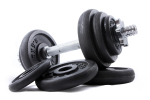|
2005/05/10, 07:59 PM
Surprise! Some Body Fat Is a Good Thing
Not all body fat is the same. While fat in our tummies can be deadly as it can increase the risk of arterial clogging, the fat that older women carry on their arms, hips, and buttocks can actually protect them from heart attacks and strokes.
According to a research study published in the March issue of Circulation: Journal of the American Heart Association, full-figured women are less likely to have plaque-clogged arteries than women whose weight is in their abdominal area. It's plaque in the arteries that ups our risk for deadly heart attacks and strokes. "All fat is not the same in women," Dr. Robert Bonow of the American Heart Association told Reuters.
Surprise! Being overweight isn't necessarily bad--as long as the weight is in the right place. In fact, one of the study findings by the Center for Clinical and Basic Research in Denmark showed that obese women who carry their weight all over their bodies actually have a lower risk of arteriosclerosis than women who are not overweight. In this case, the extra weight has a protective effect. (Yeah, you read that right.)
Lead researcher Laszlo B. Tanko calls this all-over body fat peripheral fat. He thinks it may secrete substances that improve insulin sensitivity, which then improves metabolism. Abdominal fat does just the opposite. And that's why men are at risk. Obesity is still a strong risk for arteriosclerosis for men, largely because when they pack on the pounds, it all lands in the belly.
Tanko did point out that overweight women are still at risk for heart attack and stroke if they have these risk factors: diabetes, high blood pressure, or high cholesterol.
So this isn't a ticket to eat all you want and become a couch potato. Warns the American Heart Association's Bonow, "Since we can't design our bodies and direct fat to specific locations, it's important to exercise and watch our weight."
-from
http://channels.netscape.com/ns/homerealestate/package.jsp?name=homerealestate/goodbodyfat/goodbodyfat&floc=HR-1-L1
The Most Dangerous Kind of Body Fat
The most dangerous kind of body fat is the deep-hidden belly fat around your organs. You can't see it. And it only accounts for 15 percent to 20 percent of total body fat in slightly overweight, middle-aged men and even less in pre-menopausal women. But intra-abdominal fat or visceral fat can be deadly since it increases your risk for diabetes, heart disease, stroke, and some types of cancer. It's also linked to high cholesterol, high insulin, high triglycerides, high blood pressure, and other problems.
How do you know if you have a little depot of visceral fat? You don't have to be obese or even overweight to have visceral fat. According to a study published in the Journal of the American Medical Association, the only real way to determine if you have it is with an expensive CT or MRI scan, but one quick test is to touch your pelvic bones with your fingers and contract your abdominal muscle wall. Is your abdominal muscle wall sticking out? If so, it's the intra-abdominal fat that pushes those muscles out.
You can also measure your waist. Those who are most at risk for visceral fat are men whose waists are wider than 40 inches and women whose waists are larger than 35 inches. Does this sound like you or someone you love? If it is, to put it bluntly, "You've fallen off the edge of the cliff," George Blackburn, associate director of the division of nutrition at Harvard Medical School, told USA Today.
People whose waists are several inches smaller than this could also be at risk since doctors don't know the optimal waist size for good health. Blackburn says that knowing your waist size--and doing something about it if it's too big--is as important as knowing your height, weight, and body mass index (BMI).
So what can you do to rid yourself of visceral fat? Exercise and lose weight. The best exercise appears to be 30 to 45 minutes of brisk walking five days a week. Walk briskly as if you're late for work! Your efforts will pay off big time. It appears that visceral fat could be the first kind of fat to be lost when you drop weight through exercise, Anne McTiernan from the Fred Hutchinson Cancer Center in Seattle, told USA Today. This could be why we often find our clothes fit better when we start a new exercise program even if we don't lose weight immediately.
When this fat is burned off, you may not see a lot of movement on the scale, but it could add years to your life.
--Cathryn Conroy
from
http://channels.netscape.com/ns/homerealestate/package.jsp?name=homerealestate/badbodyfat/badbodyfat&floc=HR-1-L2
|



